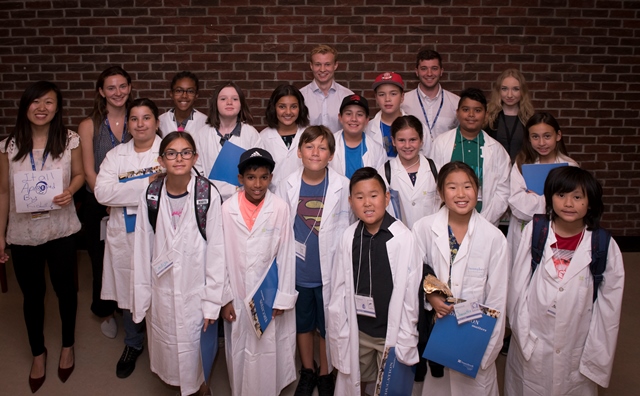
By Alexis Dobranowski
A group of enthusiastic 5th graders took some time out of their summer vacations this week to visit Sunnybrook for a special contest.
As part of the Sunnybrook Research Institute 407 ETR Summer Student Research Day, Sunnybrook’s summer students were invited to submit a simple summary of their work in a way the public – even kids – would understand. More than 70 projects were submitted. Five finalists competed for a cash prize.
Fifteen youngsters took part in judging the finalists, who presented complicated research about using virtual reality to help detect Alzheimer’s disease, Ontario’s platelet transfusion rates, teaching spinal surgery, using focused ultrasound to get drugs into the spinal cord, and how high temperatures might affect doctor’s performance — all using simple language.
 “My study is trying to research the ways to make it safer for doctors and nurses to treat patients with Ebola. At the Toronto military base, we have a temperature chamber that can be set to both hot and cold conditions,” explained Sarah Mullin, who worked this summer with Dr. Rob Fowler. “During the study, the doctors have to put on full protective gear and perform medical procedures on mannequins inside the temperature chamber. Researchers watch the doctors from a window outside the hot chamber and use a checklist to grade their performance on these tasks.”
“My study is trying to research the ways to make it safer for doctors and nurses to treat patients with Ebola. At the Toronto military base, we have a temperature chamber that can be set to both hot and cold conditions,” explained Sarah Mullin, who worked this summer with Dr. Rob Fowler. “During the study, the doctors have to put on full protective gear and perform medical procedures on mannequins inside the temperature chamber. Researchers watch the doctors from a window outside the hot chamber and use a checklist to grade their performance on these tasks.”
The young students listened carefully and asked questions to make sure they understood the presentations.
Miles Jonson, a student at University College Dublin, was awarded first place for his presentation called: Can 3D Video Games Help Detect Alzheimer’s Disease?
“Have you ever gotten lost on your way to the kitchen to find ice cream? That might sound silly. How can you get lost in your own house? For most people, finding their way around their home, their neighbourhood and their school is easy. But for people with some types of brain disease, like Alzheimer’s Disease, it can make remembering where the ice cream is, and even getting around places you know, like your home, really hard,” Miles explained.
 Miles spent his summer with supervisor Dr. Fahad Alam, working on a 3D virtual reality maze that may help doctors detect and eventually treat Alzheimer’s Disease.
Miles spent his summer with supervisor Dr. Fahad Alam, working on a 3D virtual reality maze that may help doctors detect and eventually treat Alzheimer’s Disease.
Miles said participating in the 5th Grader Day was a lot of fun.
“The kids were really engaged and asked really great questions,” Miles said. “Events like this are important for the kids because it gives them an opportunity to learn about new and innovative science at a level geared towards their understanding.”
And, he said, it’s just as important for the researchers.
“It ensures that we truly understand our own work to a depth that we can explain it to anyone. In a medical context, this is important to help explain issues and concepts to patients.”
In addition to the presentations, the young students tried their hands at pipetting with scientist Jarkko Ylanko and checked out some very realistic mannequins and equipment in the Sunnybrook Canadian Simulation Centre with educator Susan De Sousa and simulation specialist Roman Tymchal.
The Tell it to a 5th Grader Research Day is part of Sunnybrook’s ongoing effort to involve the community in all aspects of the health-care setting and bring research to the public.
Congratulations to Miles and the other finalists: Sarah Mullin, MaryJane Hill-Strathy, Daniel Sherman and Christina Ding.
A big thank you to all our judges: Adnan, Ari’i, Christopher, Emilija, Emma, Hazel, Jacob, Jordyn, Mateo, Olivia, Rose, Samantha, Sam, Stephen and Sydney.
Alexis Dobranowski is a communications advisor at Sunnybrook Health Sciences Centre.

